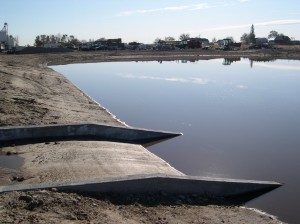
Most wastewater ponds rely on sunlight and wind to function properly. Sunlight allows aquatic algae to produce oxygen. Wind action stirs up the water surface, which helps mix the depth layers. Both mechanisms – sunlight and wind – help infuse oxygen into the pond.
Although a small percentage of livestock facilities mechanically aerate one or more of their impoundments, most do not. Pond aeration is useful for accelerating the decomposition of organic compounds and controlling odors. The downside is that aeration requires energy, which carries an associated cost.
Most livestock wastewater impoundments have three functional layers; the top aerobic layer, the middle layer – which has both aerobic and anaerobic bacteria present – and the bottom layer, which is anaerobic.
Under stable conditions, the beneficial effects of sunlight and wind help keep the top layer well-oxygenated – which allows aerobic bacteria to thrive. The aerobic layer at the top forms a “cap” over the pond, which helps reduce undesirable odor emissions.
When a significant amount of precipitation runoff or process-generated wastewater enters the pond, mixing occurs and the aerobic cap is disrupted. The new wastewater inflow also brings additional organic compounds into the pond, which places greater demand on available oxygen and results in greater anaerobic digestion. Both of these actions result in stronger odor emissions.
Preventing solids from entering wastewater impoundments helps reduce malodorous emissions by reducing organic loading into the pond. Solid separation of runoff is generally accomplished with the use of a solid-settling channel or holding structure. Utilizing multiple solid settling structures in a series further helps reduce solids entry into impoundments, and preserves storage volumes. Solid settling structures should be designed to provide adequate detention time to allow solids to drop out of suspension. Additionally, they should be designed with easy access in mind, to enable frequent solids removal.
To ensure your wastewater impoundment is functioning at peak performance, it’s also a good idea to eliminate trees and tall weeds on pond banks and berms, which can block sunlight and wind.

